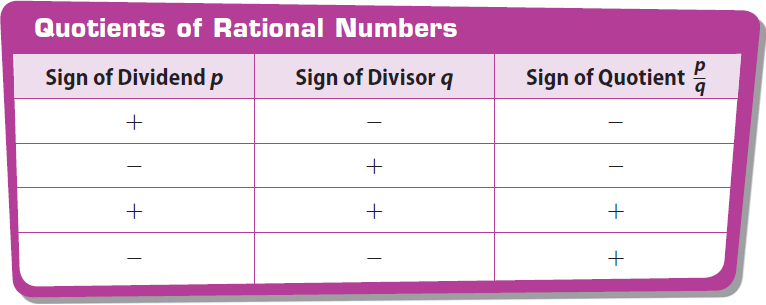DIVIDING RATIONAL NUMBERS
Subscribe to our ▶️ YouTube channel 🔴 for the latest videos, updates, and tips.
To divide a rational number by another rational number, we have to multiply the dividend by the reciprocal of the divisor.
The rules for the sign of quotient are summarized below.
Let p and q be rational numbers.

Example 1 :
Divide 2/3 by -7/6.
Solution :
Step 1 :
Take the reciprocal of the second rational number.
-7/6 ----> reciprocal ----> -6/7
Step 2 :
Multiply the first rational number 2/3 by -6/7.
(2/3) x (-6/7)
Step 3 : Simplify
(2/1) x (-2/7)
Step 4 : Multiply
(2/1) x (-2/7) = -4/7 Positive times negative equals negative
So,
2/3 ÷ -7/6 = -4/7
Example 2 :
Divide -2 by 8/3.
Solution :
Step 1 :
Take the reciprocal of the second rational number.
8/3 ----> reciprocal ----> 3/8
Step 2 :
Multiply the first rational number 2 by 3/8.
(-2) x (3/8)
Step 3 : Simplify
(-1) x (3/4)
Step 4 : Multiply
(-1) x (3/4) = -3/4 Positive times negative equals negative
So,
-2 ÷ 8/3 = -3/4
Example 3 :
Divide 9/5 by 3.
Solution :
Step 1 :
Take the reciprocal of the second rational number.
3 ----> reciprocal ----> 1/3
Step 2 :
Multiply the first rational number 9/5 by 1/3.
(9/5) x (1/3)
Step 3 : Simplify
(3/5) x (1/1)
Step 4 : Multiply
(3/5) x (1/1) = 3/5 Positive times positive equals positive
So,
9/5 ÷ 3 = 3/5
Example 4 :
How many quarters are in 8?
Solution :
One quarter = 1/4
Number of quarters in 8 :
= 8 ÷ (1/4)
Step 1 :
Take the reciprocal of the second rational number.
1/4 ----> reciprocal ----> 4
Step 2 :
Multiply the first rational number 8 by 4.
8 x 4 = 32 Positive times positive equals positive
There are 32 quarters in 8.
Example 5 :
How many halves are in 7?
Solution :
One half = 1/2
Number of halves in 7 :
= 7 ÷ (1/2)
Step 1 :
Take the reciprocal of the second rational number.
1/2 ----> reciprocal ----> 2
Step 2 :
Multiply the first rational number 7 by 2.
7 x 2 = 14 Positive times positive equals positive
There are 14 halves in 7.
Example 6 :
How many three-fourths are in 6?
Solution :
Three-fourth = 3/4
Number of three-fourths in 6 :
= 6 ÷ (3/4)
Step 1 :
Take the reciprocal of the second rational number.
3/4 ----> reciprocal ----> 4/3
Step 2 :
Multiply the first rational number 6 by 4/3.
6 x (4/3)
Step 3 : Simplify
2 x (4/1)
Step 4 : Multiply
2 x (4/1) = 4 Positive times positive equals positive
There are 4 three fourths in 6.
Example 7 :
How many one-fifths are in 10?
Solution :
One-fifth = 1/5
Number of one-fifths in 10 :
= 10 ÷ (1/5)
Step 1 :
Take the reciprocal of the second rational number.
1/5 ----> reciprocal ----> 5
Step 2 :
Multiply the first rational number 10 by 5.
10 x 5 = 50 Positive times positive equals positive
There are 50 one-fifths in 10.
Example 8 :
A diver needs to descend to a depth of 100 feet below sea level. She wants to do it in 5 equal descents. How far should she travel in each descent ?
Solution :
To find how far she should travel in each descent, we have to divide 100 by 5.
Step 1 :
Take the reciprocal of the divisor 5.
5 ----> reciprocal ----> 1/5
Step 2 :
Multiply 100 by 1/5
(100) x (1/5)
Step 3 : Simplify
(20) x (1/1)
Step 4 : Multiply
(20) x (1/1) = 20
So, she should travel 20 feet in each descent.
Subscribe to our ▶️ YouTube channel 🔴 for the latest videos, updates, and tips.
Kindly mail your feedback to v4formath@gmail.com
We always appreciate your feedback.
About Us | Contact Us | Privacy Policy
©All rights reserved. onlinemath4all.com
Recent Articles
-
AP Calculus BC Problems with Solutions
Dec 20, 25 10:51 AM
AP Calculus BC Problems with Solutions -
AP Precalculus Problems and Solutions (Part - 1)
Dec 20, 25 10:49 AM
AP Precalculus Problems and Solutions (Part - 1) -
AP Calculus AB Problems with Solutions (Part - 1)
Dec 20, 25 10:49 AM
AP Calculus AB Problems with Solutions (Part - 1)
